Every autumn, E.C. Manning Provincial Park plays host to a little colour-changing magic. This is all thanks to the Frosty Mountain larches, which turn a gorgeous golden yellow.
These alpine larch trees, backdropped by spectacular mountain views, are a sight to behold. This is especially true on a sunny day when the gold-coloured needles contrast wonderfully against the blue sky.

Beautiful as they are, alpine larch trees are also some of the hardiest and most ancient trees in BC. Despite their small size, some of the trees in Manning Park are almost 2000 years old!
Read on to discover everything you need to know about visiting the Frosty Mountain larches in Manning Park including when to go, how to hike there and what to bring.
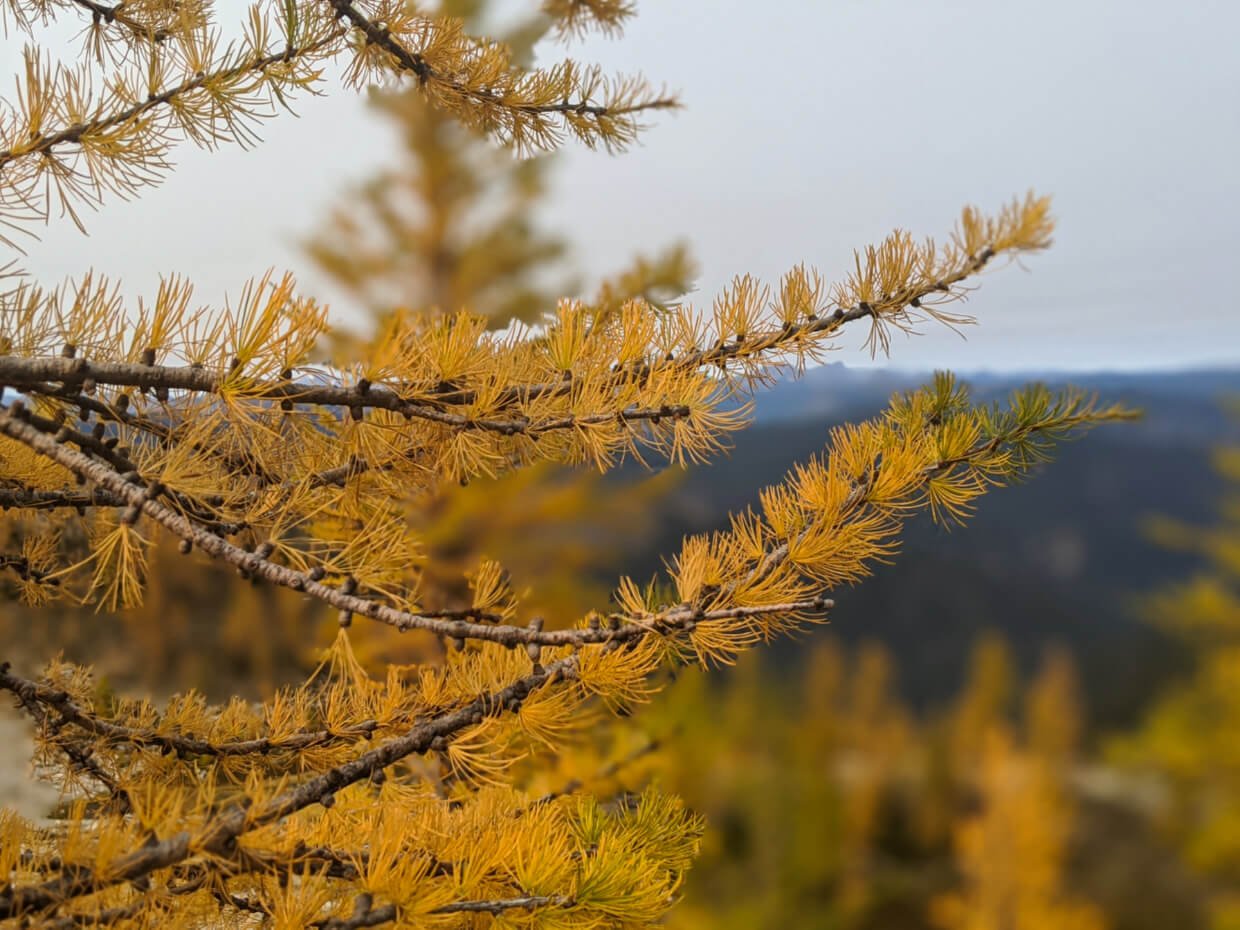
Backcountry necessities
- Always bring the 10 Essentials
- Know how to stay safe in the backcountry
- Remember to Leave No Trace to help keep the wilderness wild
- Understand how to avoid negative bear encounters
- Trying out backpacking for the first time? Read Backpacking 101
- Check out our packing guide with gear recommendations
- Sign up to our newsletter for a free backpacking checklist
Why larch trees are so special
Alpine larch (or Larix lyallii) are one of the only coniferous, deciduous trees. Despite having cones like evergreen trees, alpine larch also drop their needles every autumn. Before doing so, the needles turn a gorgeous golden yellow colour for a short time.
The beautiful autumn colours make it easy to love alpine larches but these trees are pretty special for a number of other reasons as well:
- Alpine larch thrive above 2000 meters elevation, surviving extreme weather conditions and low temperatures
- Due to slow growth, alpine larch trees may look small but are actually some of British Columbia’s oldest trees!
- Alpine larch trees grow best at elevation in dry, cold climates. For this reason, alpine larch forests are pretty rare
There are affiliate links below – if you make a purchase via one of these links, I may receive a percentage of the sale at no extra cost to you.

The Frosty Mountain larches
The biggest concentration of alpine larch trees in Western Canada can be found in the Canadian Rockies, with other examples scattered around British Columbia’s southern interior region.
Manning Park is the western limit for alpine larch trees in BC and hence the closest place to Vancouver to see alpine larch trees.
The best place to see alpine larch trees in Manning Park is in a meadow below Frosty Mountain.
The Frosty Mountain Trail travels right through this alpine larch meadow, offering a chance to get close to these ancient trees and witness their dramatic colour change in autumn.
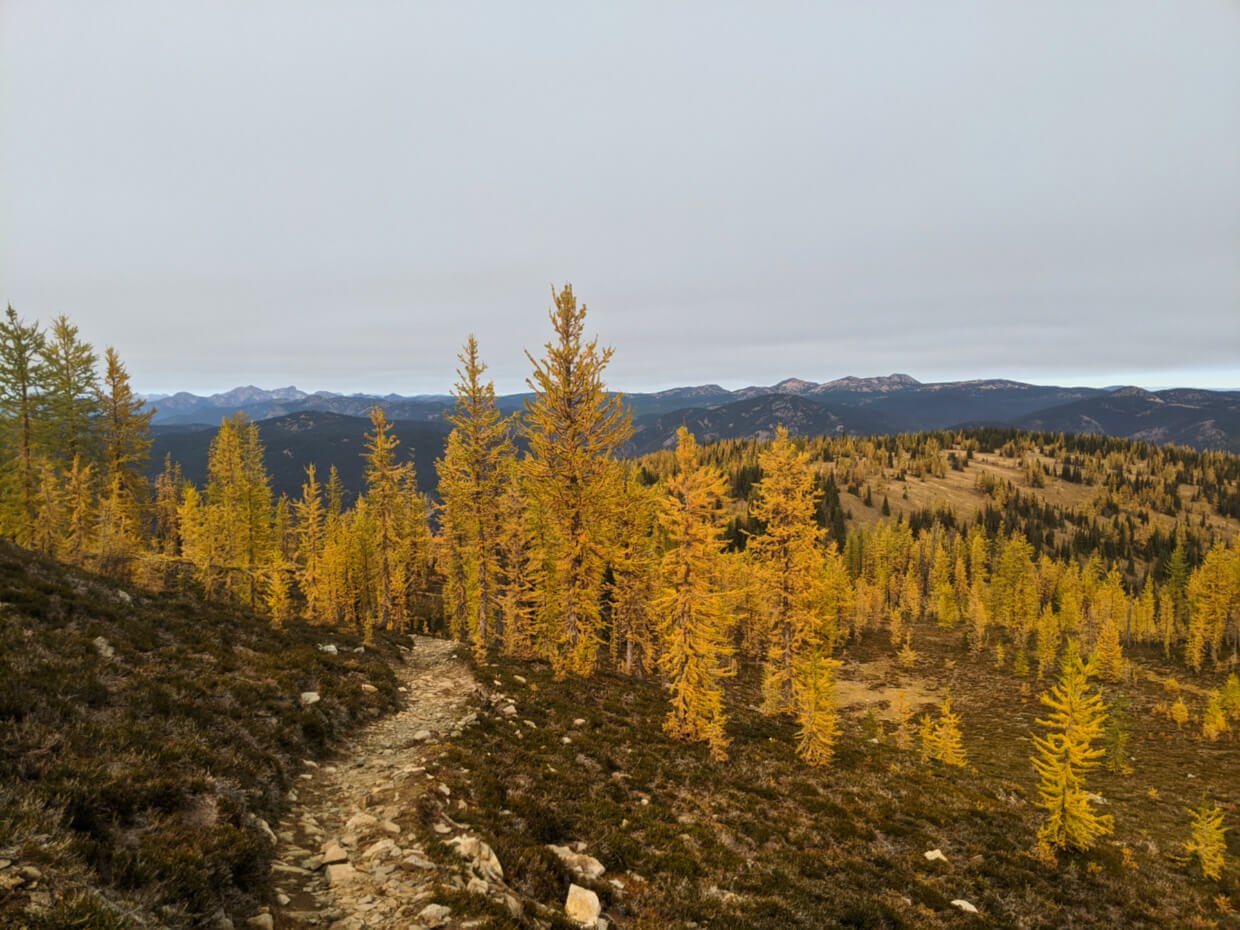
When to see the Frosty Mountain larches
The Frosty Mountain larches usually turn golden at the end of September or early October. The start time (and duration) changes from year to year and is weather dependent.
- The easiest way to find out if the larches have started to change is to utilise Instagram – check the most recent photos posted with the #manningpark hashtag or follow Manning Park Resort’s account.
- Be careful not to wait too long to see the Frosty Mountain larches – visit too late and the trees will have dropped their needles. The peak colours sometimes only last a week or so
- Due to the limited daylight hours at the end of September, it is a good idea to start hiking to the larches early in the morning. It will also be quieter and easier to find a parking spot.
- Frosty Mountain is very, very busy on golden larch weekends (1000+ hikers) For this reason, I’d recommend visiting on a weekday.

The weather can be super variable during larch season. It was 23c and mostly sunny the last time we hiked Frosty Mountain (end of September). Only a couple of days before, it was snowing and freezing cold.
For this reason, it is so important to be prepared and bring clothing suitable for warm and cold weather.
This includes multiple warm layers, an insulated jacket, a waterproof jacket, gloves, warm hat, scarf/Buff etc. Micro-spikes are useful for snowy or icy conditions.
Skip to ‘what to bring’ section
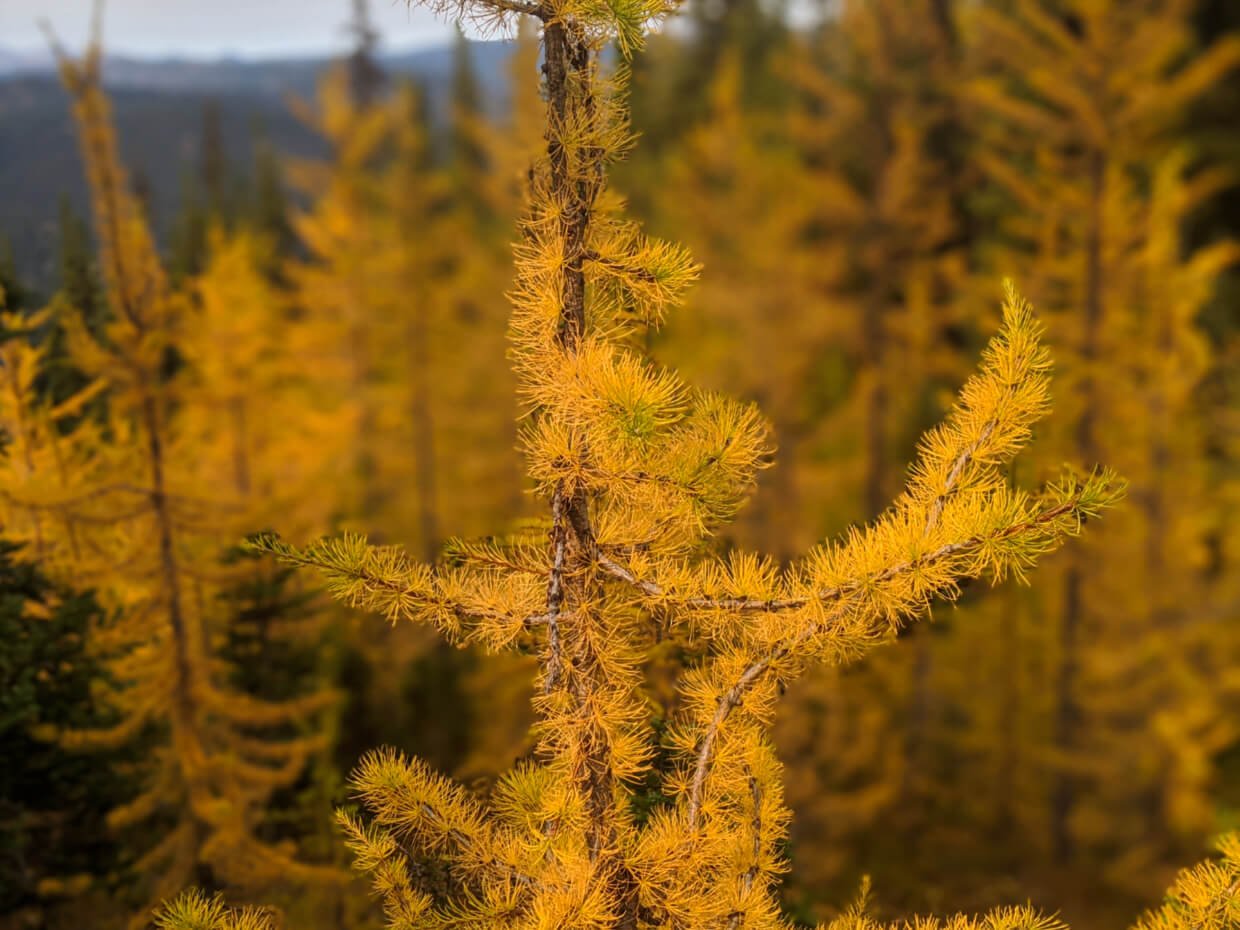
Frosty Mountain Larches: Hiking Guide
The Frosty Mountain larches are located right on the Frosty Mountain Trail.
This hike starts at the Lightning Lakes Day Use Parking Lot and leads 11km to the Frosty Mountain summit. At the 8km mark, the trail traverses the gorgeous alpine larch meadow.
If you’re planning to visit the Frosty Mountain larches and are an intermediate hiker, I’d recommend hiking all the way to the summit as well (weather conditions permitting).
At 2423m, Frosty Mountain is the highest peak in E.C. Manning Provincial Park.

The panoramas from Frosty Mountain are spectacular, encompassing boundless views of rugged mountain ranges in both Canada and the US. Think of it as the icing on the cake of your larch experience!
Technically, the Frosty Mountain Trail descends from the ridge near the summit and links up with the Pacific Crest Trail near Windy Joe Mountain.
This means it is possible to hike Frosty Mountain as part of a 27km loop. The most popular route, however, is the out-and-back hike described below.
Mount Frosty Trail
Location: E.C. Manning Provincial Park
Distance: 21km (16km to alpine larches)
Elevation gain: 1150m (800m to alpine larches)
Hike type: Out and back
Time: 6-9 hours to summit and back (less to alpine larches)
Difficulty: Moderate with short, challenging ascent to ridge
Camping: Frosty Creek Wilderness Camp at 7km
Fees: $5/per person/per night for camping plus $6 reservation fee
Dogs: Permitted on leash

Essential trail info
- The Frosty Mountain Trail is open all year but is best (and most easily) hiked from July to September. The trail is most likely to be snow free during this period.
- The weather can change quickly in the alpine and any type of weather is possible at any time of year! Read the ‘what to bring’ section below for more info
- The Frosty Mountain Trail is VERY popular during larch season – try to visit on a weekday if you can. Even then, expect the trail to be busy (on a Wednesday, we saw 100+ people)
- Stay on the hiking path at all times. The larch forest is located in a sensitive area and walking off the path can cause long standing damage. It also reduces the chance of getting lost in bad weather
- Prepare to Leave No Trace. Whatever you bring to Frosty Mountain, plan to bring home with you. That includes trash, orange peels, and granola bar wrappers!
- The Lightning Lake Day Use area has picnic benches and outhouses. There is also a boathouse with canoe rentals
- Phone service is limited in Manning Park – it is most consistent by the Resort and at higher elevations
- Dogs are allowed on the Frosty Mountain Trail but on leash only

Camping need to know
- Reservations are required for Frosty Creek Campground between between 26th July and 20th October (new for 2024).
- The reservations system operates using a four month rolling window. Reservations can be made online or by phone
- The reservation fee is $6 per tent. The camping fee is $5 per adult, per night
- The Frosty Creek Wilderness Camp is set into the forest (no views) and has an outhouse, bear cache for food storage and a number of flat spots for tents. There is a rustic cabin with no door and floor. A creek runs through the camp but can be almost dry by late summer
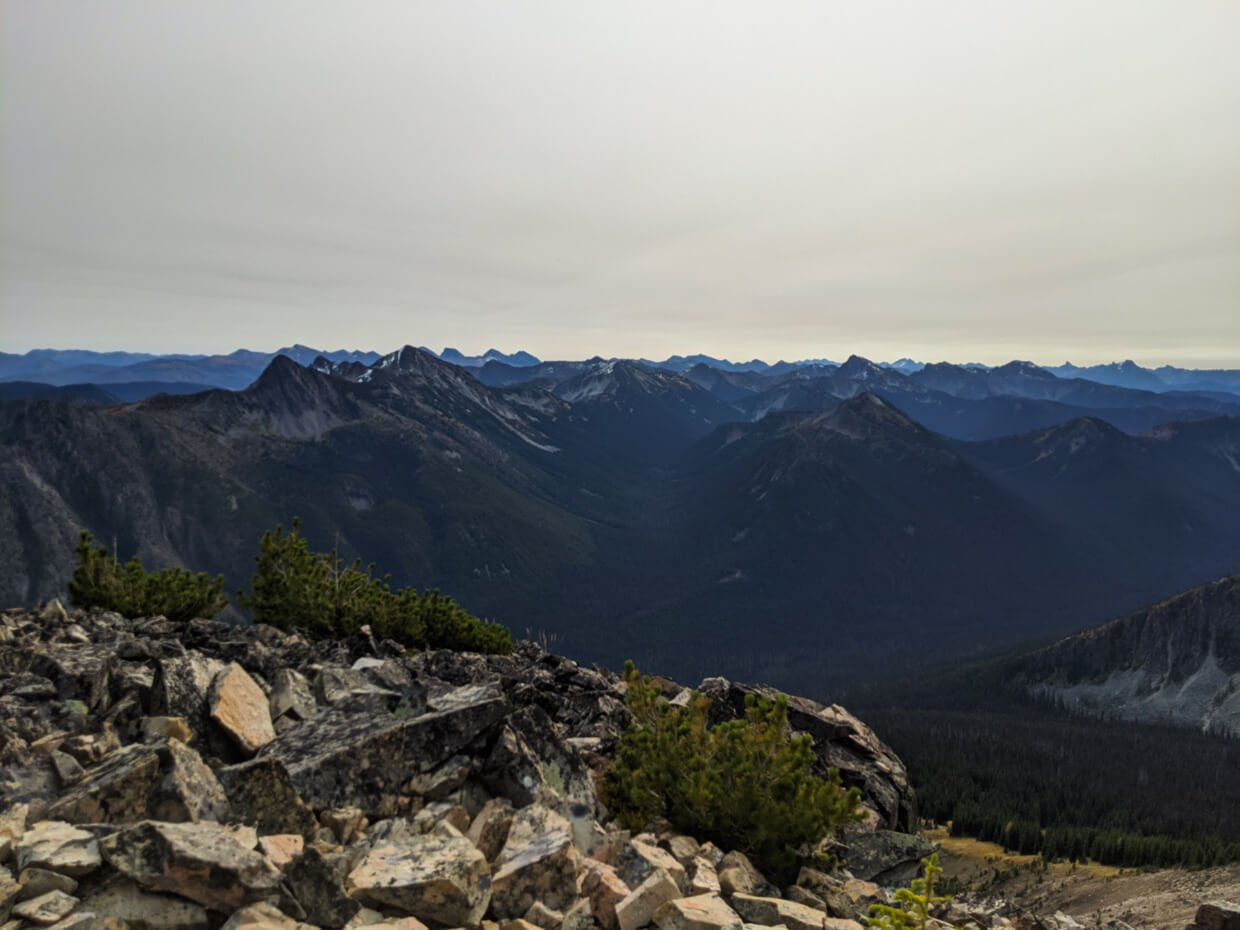
Hike experience
The Frosty Mountain Trail starts at the Lightning Lake Day Use Parking Lot, 3.5km from Manning Park Resort. From here, head towards the end of the lake (left, if standing in front of the lake).
Cross the bridge and follow the trail signage. Just past the end of the lake, there is the trailhead proper (marked with a sign).
A slow and steady ascent through the forest starts here, with long switchbacks winding around the base of the mountain.
The path is quite narrow and there are a couple of short sections of mud, rocks and roots near the beginning.

The climb continues for 5km, with peek through views Lightning Lake and surrounding mountains appearing through the trees as height is gained.
The path finally levels out and becomes almost completely flat for the approach to the Frosty Creek Wilderness Camp (7km mark). There is an outhouse and basic shelter here.

Leaving the camping area, the ascent begins again but scattered larch trees also start to appear.
The trail soon levels out onto a plateau (8km) and you’re now in the main part of the larch meadow – look for the BC Parks ‘Mountain Monarch’ interpretive sign.
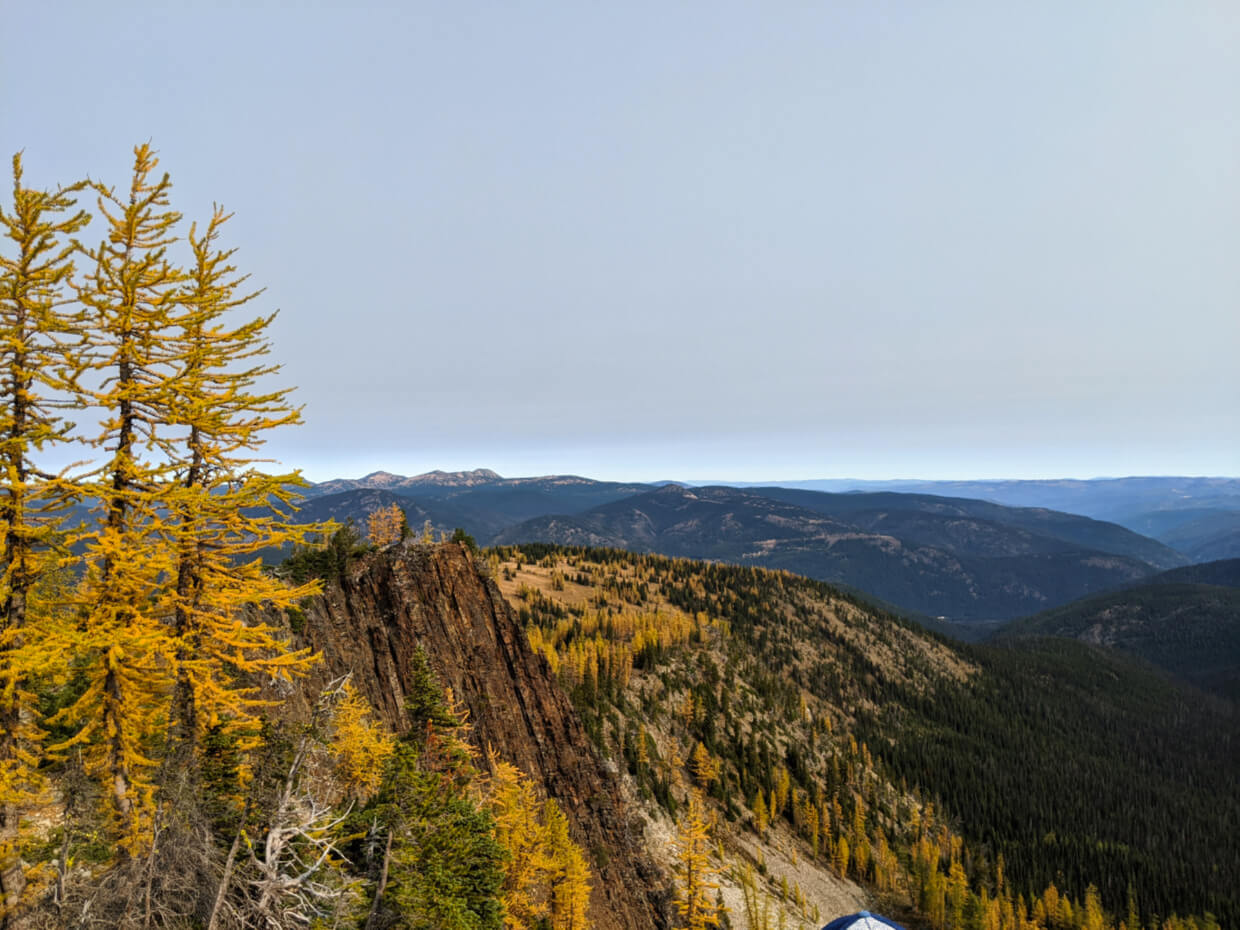
After another fairly flat section, the path starts to climb again (9km) as it winds through the larch trees.
There are a number of excellent viewpoints of the larch meadows, Mount Frosty and surrounding peaks before the trail reaches a ridge (9.5km).
If you’re not comfortable with exposure, scree and/or only want to see the alpine larch, I’d recommend turning around here. The weather conditions will also dictate if you can go further at this point.

Summiting Frosty Mountain
To ascend to the ridge, hikers must pick their way up a steep scree slope. There is an established switchback route, though it can be difficult to see at times.
Look out for rocks painted with purple arrows or red stickers and be careful of loose rocks. I had to use my hands at a couple of points but my hiking partner did not.
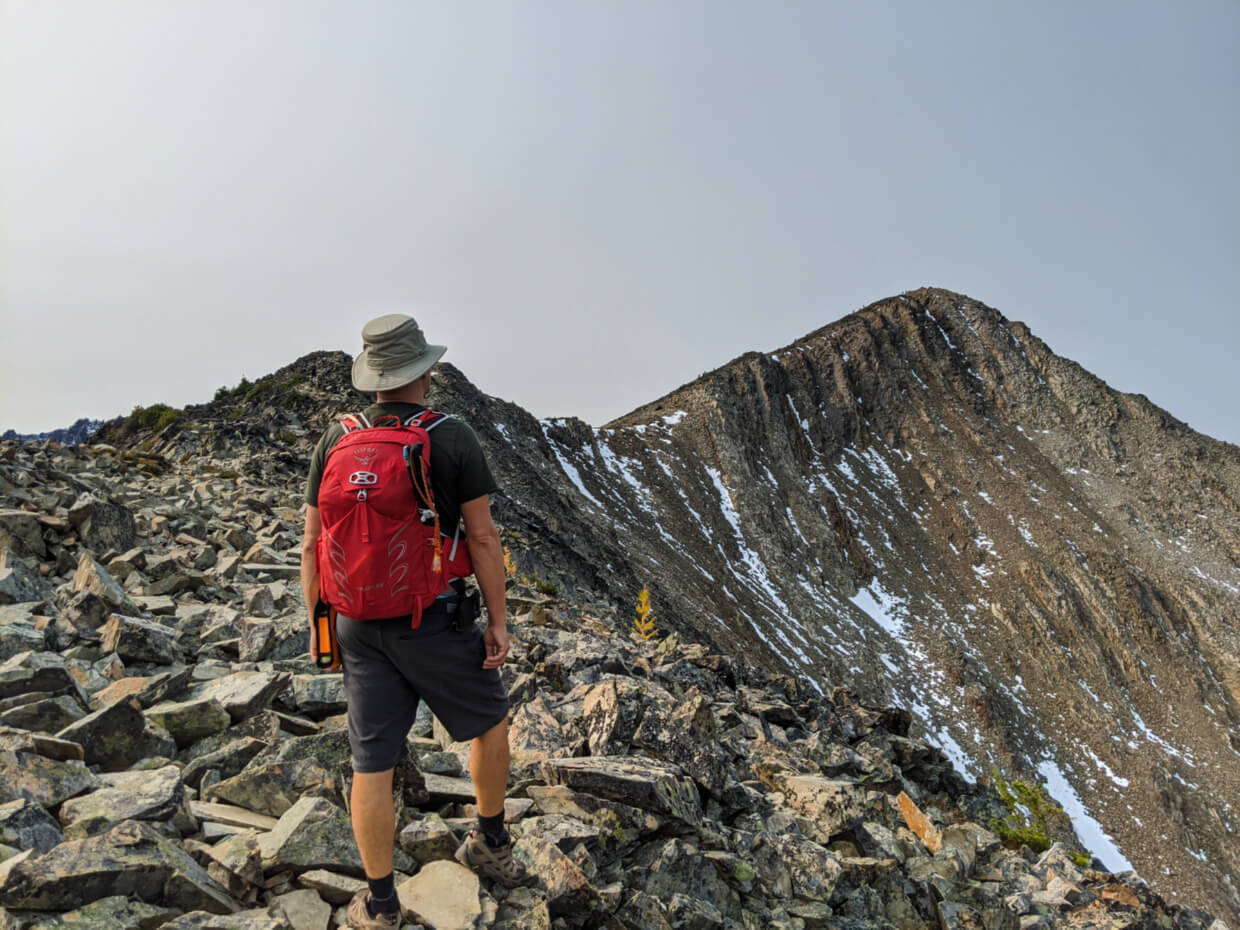
There is a ‘Windy Joe’ sign at the top of the ridge (10km), marking the return route for hikers completing the Frosty Mountain loop.
To continue to the summit, stay on the ridge. From here, it is only 500m to the summit.
Although a little precarious looking from afar, the ridge is surprisingly wide for the most part.
Again, there is a marked route but take it slow. The final ascent involves another short climb with switchbacks.
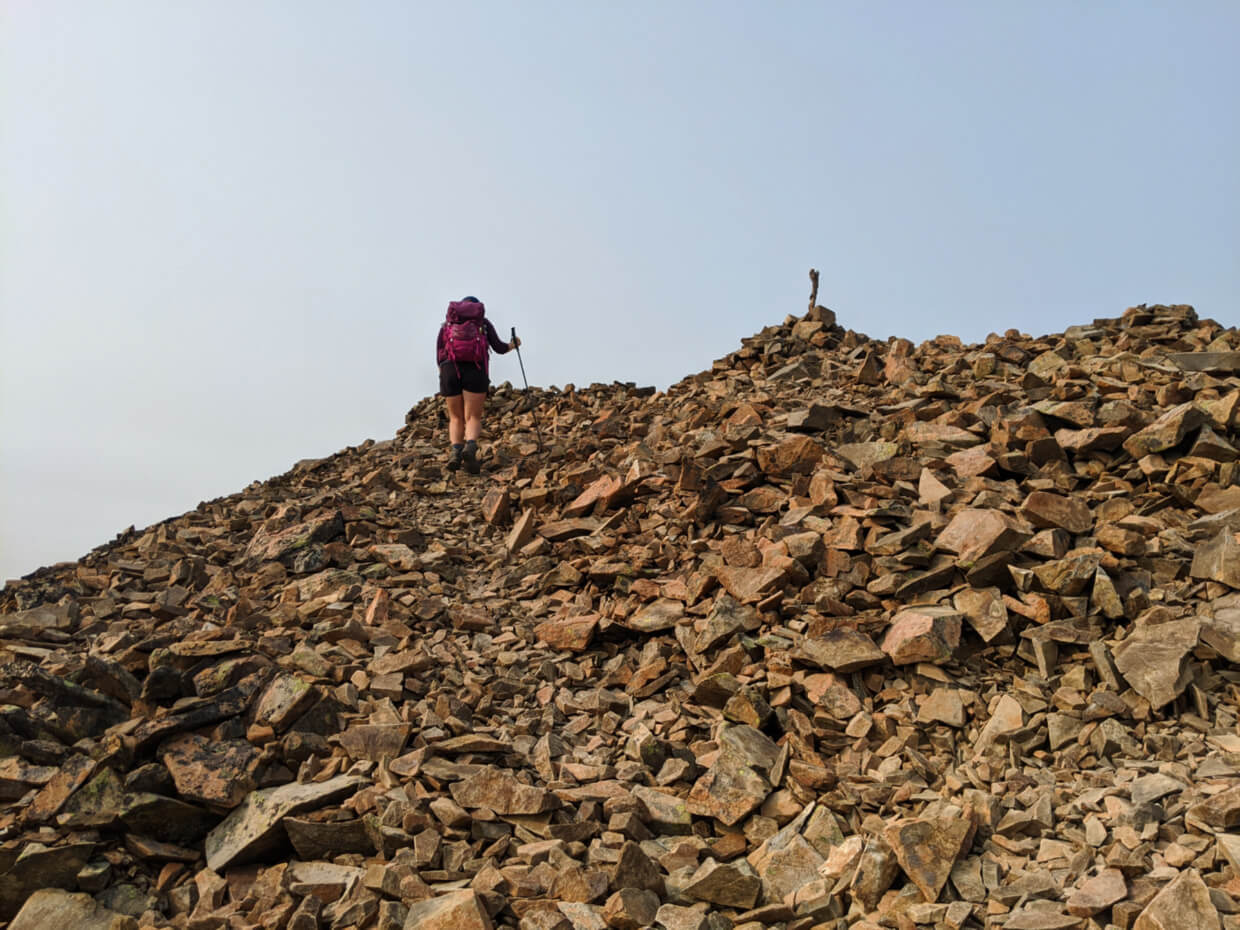
Welcome to the (eastern) Frosty Mountain summit! The slightly higher true summit sits to the west but is more difficult to reach.
Enjoy the incredible vistas of the Cascade Mountains all around you before heading back down the same way.

What to bring
Frosty Mountain is a long, sometimes challenging, day hike into the alpine.
The weather can change quickly along the trail so it’s crucial to bring appropriate clothing and gear.
Even if the conditions look favourable in the parking lot, the situation can be very different at higher elevations.
This is particularly true during larch season, when winter weather is possible. For this reason, bring clothing suitable for warm and cold weather. This includes (but is not limited to):
- Multiple warm layers (I recommend merino wool)
- Insulated jacket (down or synthetic)
- Waterproof jacket
- Gloves
- Warm hat
- Scarf/Buff
- Micro-spikes for better traction on snowy/icy paths

Besides the 10 Essentials, here are some more must have items for this trail:
- Bear spray: Frosty Mountain may be a fairly busy trail but it’s still important to be prepared. Be sure to store it somewhere handy with a holster
- Toilet paper: There are outhouses at the trailhead and at Frosty Creek (7km), but don’t assume there will be any toilet paper! Bring hand sanitizer as well
- Hiking poles: The descent is long on this trail and hiking poles are nice to have. Incredibly light and foldable, Black Diamond’s Carbon Z poles are my tried and tested favourite pair
Other places to see larch trees in British Columbia
While the Frosty Mountain larches are awesome, there are other places to see beautiful larches elsewhere in British Columbia!
Here are some alpine larch destinations (golden colours in late September):
- Cathedral Provincial Park near Keremeos, Similkameen region (closed in 2024)
- Kokanee Glacier Provincial Park near Nelson, West Kootenays
- Monica Meadows, Purcell Mountains
- Jumbo Pass, Purcell Mountains
- Welsh Lakes, near Radium Hot Springs/Invermere
- Floe Lake, near Radium Hot Springs
- Bugaboos Provincial Park, near Radium Hot Springs
- Diana Lake, near Radium Hot Springs

Western larch can be found in these locations (golden colours in mid/late October to early/mid-November):
- Myra Canyon, near Kelowna
- South Star Recreation Area near Cranbrook
- Kimberley Nature Park
- Cranbrook Community Forest
- Silver Spring Lakes near Elko
Please note that some of these locations are true wilderness areas so you must be completely self-sufficient to visit (bring the 10 essentials!) and prepare for all weather conditions.
Myra Canyon is one of the most easily accessible larch destinations on this list, as is the Cranbrook Community Forest and Kimberley Nature Park.
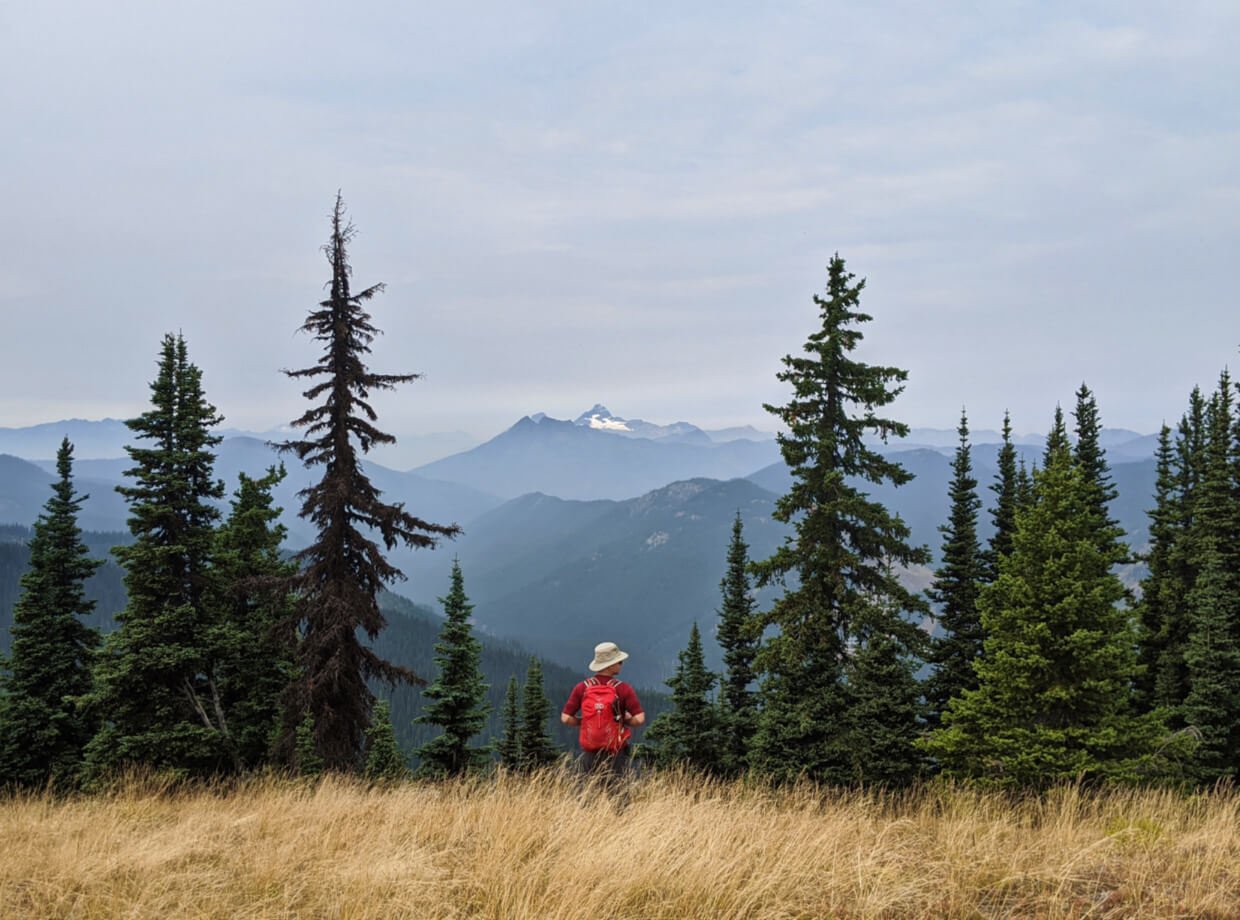
Looking for more adventure?
The Heather Trail is an equally stunning alpine hike in Manning Park. With the trailhead sitting at an elevation of 1980 m, you can enjoy the views and wildflowers without even getting out of breath!
For something a little more challenging than the Heather Trail, check out the Skyline I. The views are also excellent and it can be completed as a 16km hike with two cars or a 20km loop.


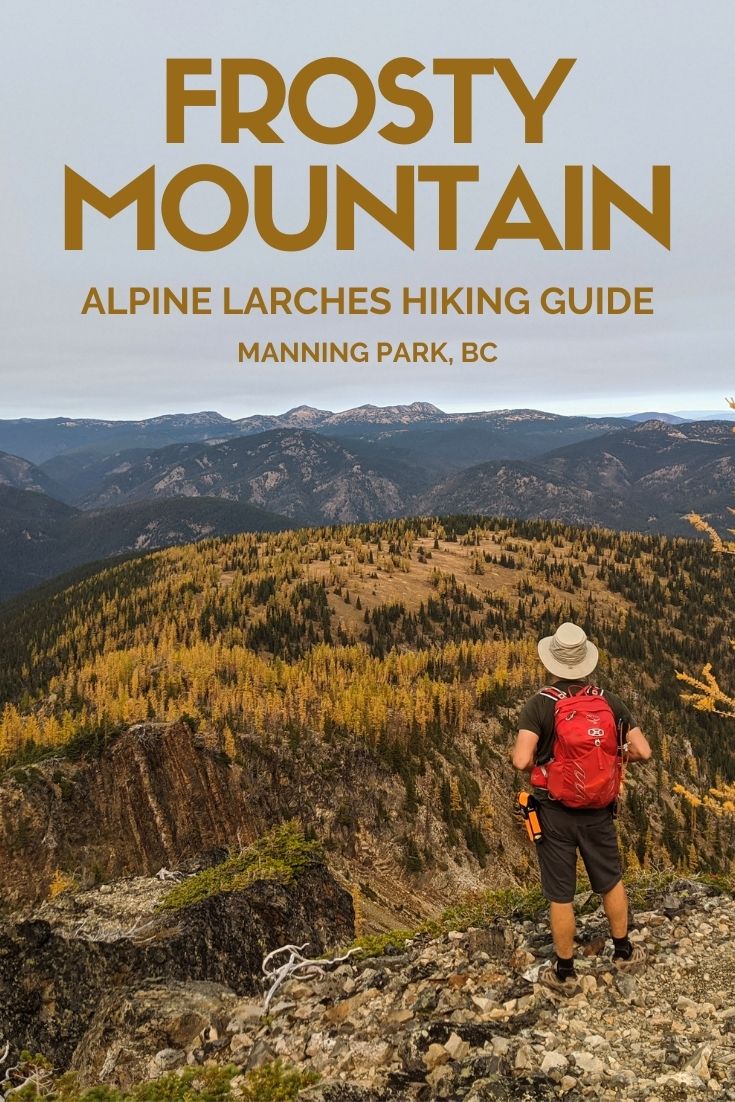

One half of the Canadian/British couple behind Off Track Travel, Gemma is happiest when hiking on the trail or planning the next big travel adventure. JR and Gemma are currently based in the beautiful Okanagan Valley, British Columbia, Canada. Consider buying us a coffee if you have find any of our guides helpful!



